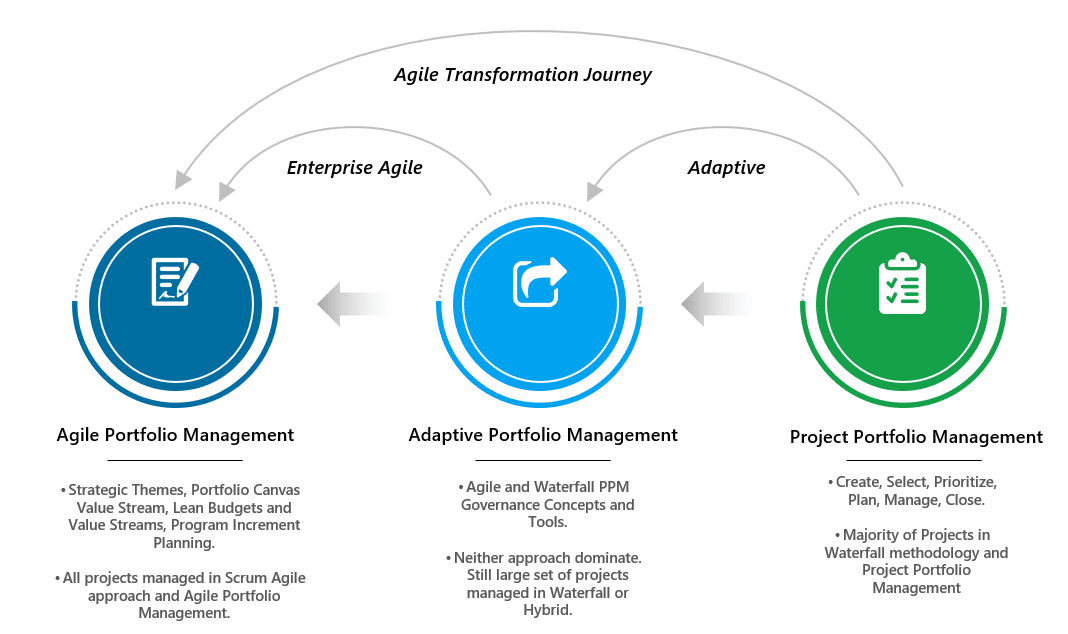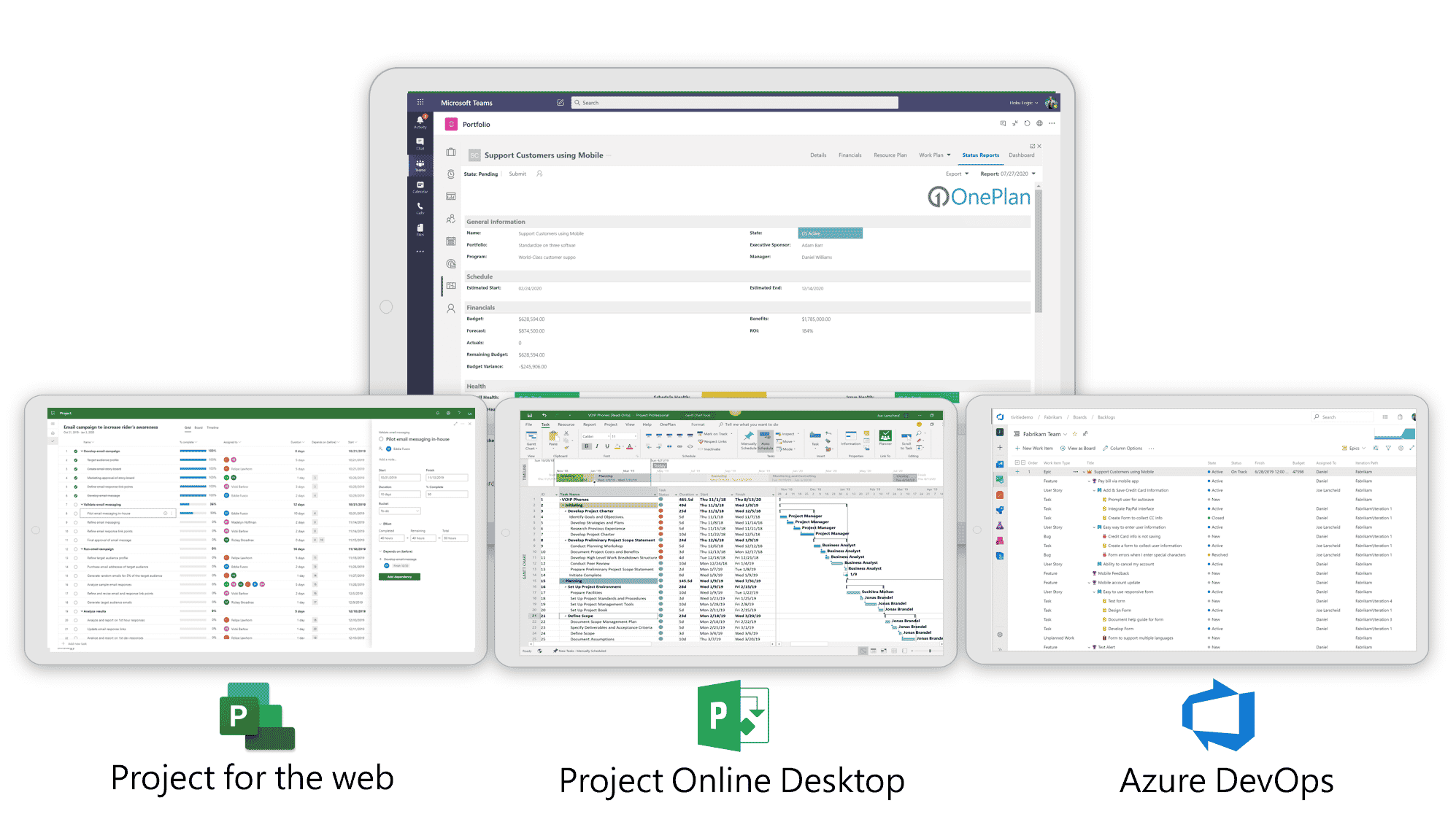The New Business Environment
The age of digital transformation forces the need for a new adaptive Project Portfolio Management (PPM) solution as companies move from brick and mortar to digital operations. The need to change the way we do business, reach our customers, alter business models, etc, must adapt quickly. An organization’s technology platform and development processes play an important role in driving this shift.
The aspiration for digital transformation brings about many changes for an organization. It begins with the senior leadership’s change in mindset to deliver value to customers quicker through digital products. Market windows that were previously in years are now as short as 12-18 months, giving less time to develop and launch new products and services.
As a result, the challenges of managing work at all levels of the organization that aligns with corporate objectives and key results increases for the enterprise.
Demands Of Modern Work Management
Several challenges need to be addressed by organizations regarding work management to achieve the rewards of digital transformation.
Because work delivered is mostly through digital means, projects across the organization come from disparate teams everywhere, 24/7. It can be very easy for information silos to lose track of outputs that contribute to overall business outcomes.
Also, thanks to cloud collaborative work management technologies and their ease of access, teams have the flexibility to choose their own tools, enabling them to work the way they want.
Everyday project managers also need something easy to work with as they haven’t been trained and lack experience using traditional Project Management tools. There’s an expectation in younger users today for applications to present information quickly and timely with a pure digital customer experience.
Finally, today’s business processes need to be viewed from a customer value perspective, crossing functions, and systems in the organization. Whether it’s cross-functional silos or geographically dispersed teams, projects are bringing in remote and dispersed participants. There is also the integration of external stakeholders, such as customer partnerships, vendors, and others outside the organization.
This means the organization needs a digital collaborative work management solution that provides transparency and enables members to see the connections between tasks, projects, and portfolios while relating them to the organization’s defined objectives and key results. The ideal digital work management solution must also be open and flexible, so teams can have the latitude to select from different approaches depending on the work they’re doing. It’s important for the solution to be designed intuitively, fast, and provide a pleasant user experience. Integration of data from any business system line is the key to providing a single view of all project and portfolio data.
On top of that, organizations are using a variety of different work methods and approaches. Just because an organization wants organizational agility doesn’t mean they must use agile methods or frameworks exclusively in the way they do projects.
As noted by PMI, “Smart organizations realize that using agile techniques, such as Scrum or DevOps, is not the only, or even the best, indicator of an organization’s speed of flexibility…and most agile organizations are more likely to use several different project management approaches.” This is because different types of work lend themselves to different frameworks, whether it’s agile or traditional waterfall. The organizations that provide the most flexibility to apply the right approach are likely the most agile.
The Case for Adaptive Portfolio Management
Analysts use the term “shifting left” when defining an organization’s desire for enterprise agility. In reality, each organization can define its own agile transformation journey. More importantly, it aims to achieve greater business agility so the organization can rapidly change strategic priorities (due to market conditions such as the 2020 global pandemic) and execution methods focused on greater customer value.
On the right-hand side, we have traditional project portfolio management, where organizations have been residing for the last 50 years. It is based on waterfall centric delivery and governance processes.
Many organizations are going through an agile transformation by shifting away from a waterfall methodology and incorporating agile scrum methods of work. However, a complete enterprise agile transformation is long term (3-5 years). While the focus can be on long term enterprise agility, a near term (1-2 year) end state is just as valuable. Newer ways of working and achieving business outcomes can co-exist with traditional methods as the organization transforms.
Even if enterprise agility with agile portfolio management is the end state, an organization may move into Adaptive Portfolio Management and stay in that mode for some time. Adaptive Portfolio Management can be a steady-state for organizations that aggregate waterfall, agile, and other hybrid work modes on the way to a full agile transformation.
An enterprise must establish where they are in this cycle and determine the end goal. The important concept is that wherever the organization is on this journey, it must continuously improve to increase its overall business agility.

What Is The Adaptive PPM Solution?
The Adaptive PPM Solution accommodates not only different work methods but also a variety of portfolios. It pulls them all together so the organizations can view project and portfolio outputs and outcomes so that decisions can be made on the use of resources vs. strategic results. An Adaptive PPM solution provides significant benefits that include:
- Greater transparency and insight for better, faster business decisions
- Ability to make quick adjustments to shifting business priorities and market changes
- Balance investments and resources with demands to optimize business value
- Support teams that use a variety of tools and execution methods
- Automate the consolidation of information from a variety of sources
- Provide a single, consolidated source of truth
Further, some teams moving to an agile approach, particularly in the execution layer, are aggressively adopting methods like Scrum and metrics like velocity. However, leadership may still want information in more traditional business metrics and at the same time translation of this information as you go up through the different levels of the organization.
OnePlan as the Unifying Solution
OnePlan provides preconfigured solutions for the different project and portfolio management approaches and the states of the agile transformation journey. Also, OnePlan provides different deployment options based on the organization’s use of the Microsoft Cloud. For instance, OnePlan can be deployed as part of the Microsoft Power platform, taking advantage of the Microsoft Business Application capabilities as a central solution to plan and track every level from strategy to execution in a very flexible Adaptive PPM framework.
OnePlan offers a strategic portfolio, financial and resource management solution that connects with a variety of tools like Microsoft Project, Azure DevOps, and more for a complete view into all work across the enterprise.
So, going back to the “shifting left” reference. Traditional PM methods might use Microsoft Project for more waterfall tasks and leverage OnePlan to manage project portfolios. For those using the adaptive model, OnePlan, Project, and DevOps can be combined into a single enterprise adaptive portfolio solution. And for those moving towards full enterprise agile, OnePlan has a solution to incorporate all agile plans (programs and portfolios) into Grids and Boards for a complete agile portfolio management capability.
One of the most notable features of OnePlan is that it was built for the Microsoft Clouds, which allows it to perform all of these capabilities with the security and collaboration available to all users with the OnePlan fused interface on Office 365. OnePlan becomes the hub of project and portfolio information that connects with external applications and other work management systems. This creates a central collaborative work management platform where the input of manual information is replaced by automation, saving time and creating efficiency in project and portfolio management for better business outcomes.
OnePlan supports transformation leadership through a mix of professional services and OnePlan technology solutions, built on the Microsoft platform.


